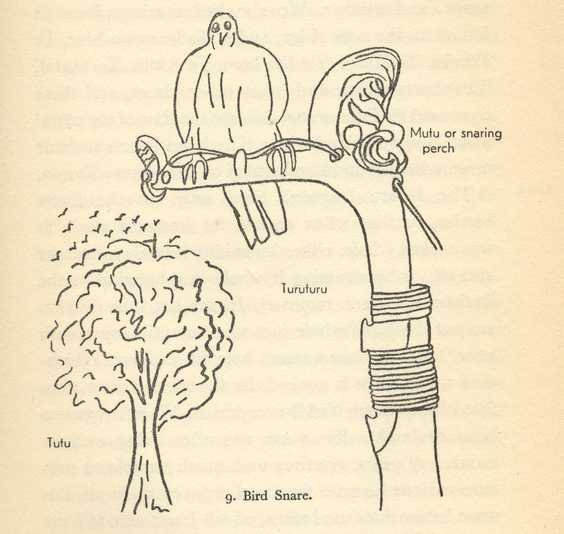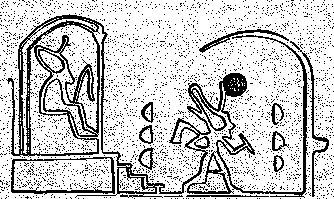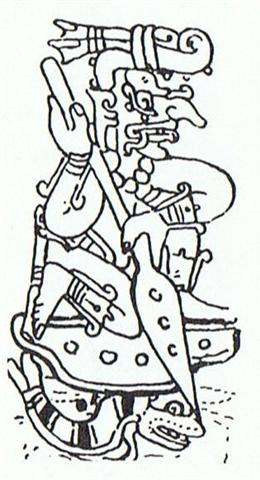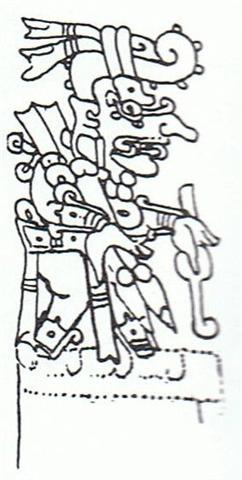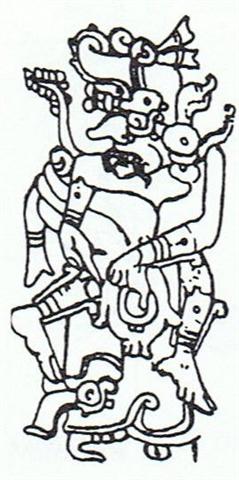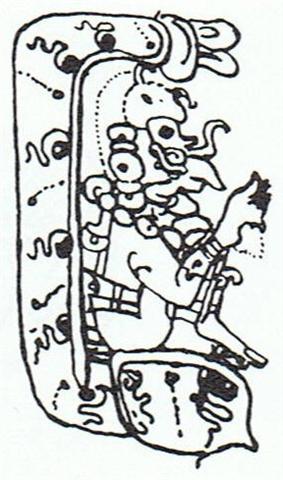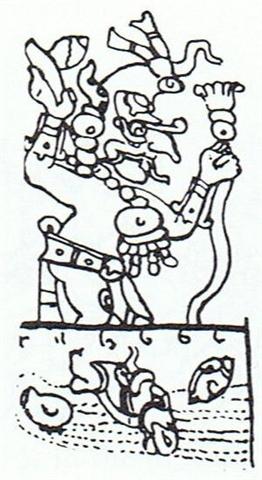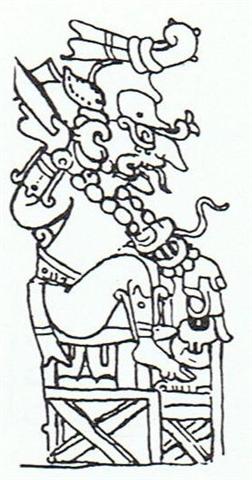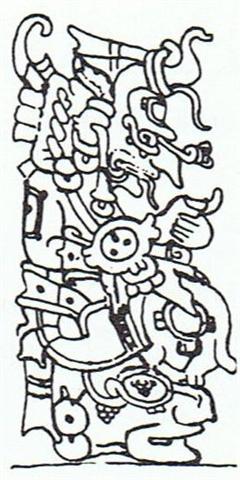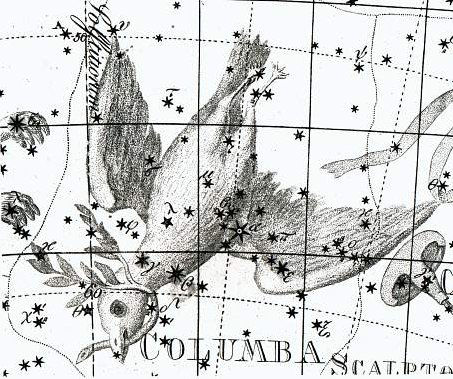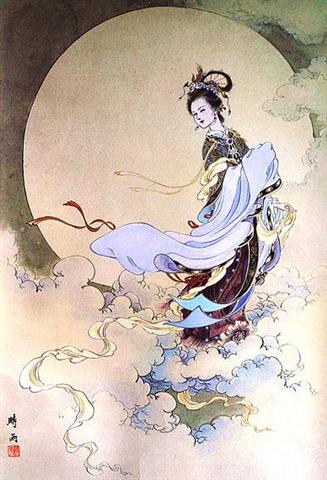|
1. Our constellation Columba is probably alluded to when Maui changes himself into a wood (significantly) pigeon by using his mother's attire. He takes on the appearance of the soft female dove. Next we should remember the Bird Snare (cfr at Parehe): ... Pewa-o-Tautoru, Bird-snare-of-Tautoru; the constellation Orion in New Zealand. The Belt and Sword form the perch, te mutu or te teke, while Rigel is the blossom cluster, Puanga, used to entice the unsuspecting bird ...
A kereru (wood pigeon) evidently does not hop about in the branches as other birds do but sits still as if caught in a snare: ... Maui now perched on the branch of a tree near his brothers, and there, just like a real kereru, he sat quite still in one place. He did not hop from bough to bough like other birds, but sat there cooing to himself. Which made his brothers coin our proverb, 'The stupid pigeon sits on one bough and does not hop from place to place.' When Maui becomes a perching kereru he is no longer a manu rere (quickly flying beast) and this Sign should mean Sun has come to a standstill. Maui personifies the sun and he has reached a solstice. To perch (said of chickens on tree branches at night) is tau, which is alluded to in Tau-toru as the name for the Belt of Orion. And suddenly we can perceive these 3 great 'stones' (stars) in the sky as the resting place for 3 'birds', for instance the 3 Pharaohs, Khufu, Khafre, and Menkaure (to mention them in withershins order). The lastmentioned was more 'down to earth' and had a much shorter life span than the first two, perhaps because he was only a human taking on the 'costume' of a Pharaoh (cfr at A Common Sign Vocabulary): ... Instead of that old, dark, terrible drama of the king's death, which had formerly been played to the hilt, the audience now watched a solemn symbolic mime, the Sed festival, in which the king renewed his pharaonic warrant without submitting to the personal inconvenience of a literal death ...
The right ascension determined by Orion and Columba has also Lepus (a constellation surely ruled by Moon) and we can guess Taranga personifies the moon. Hares do not take care of their young says the proverb: ... Did she feed us and look after us until we grew up? Not a bit of it ... Taranga is said to regularly in the early mornings go down through a hole among the rushes: ... Not far away he saw her stop and pull up a clump of rushes. There was a hole under it, which she dropped into. She pulled the rushes into place behind her, and was gone. Maui slipped out and ran as fast as he was able to the clump of rushes. He pulled it and it came away, and he felt a wind against his face as he looked through the hole. Looking down, he saw another world, with trees and the ocean, and fires burning, and men and women walking about ... Moon goes down in the east, and there should be hole there. The clump of rushes (cfr the reeds in the picture below) is probably a Sign to indicate the first period for Sun, Ce Acatl as the Mexicans said (cfr at Adjuncts): ... All this, which in so many ways parallels the normal imagery of the Old World culture-hero myths, telling of the one who is gone, dwells underground in a happy, timeless land, as lord of the realm of the happy dead, like Osiris, but will rise again, we can read without surprise. But what is surprising indeed was the manner of Quetzalcoatl's actual return. The priests and astrologers did not know in what cycle he was to reappear; however, the name of the year within the cycle had been predicted, of old, by Quetzalcoatl himself. Its sign was 'One Reed' (Ce Acatl), which, in the Mexican calendar, is a year that occurs only once in every cycle of fifty-two. But the year when Cortes arrived, with his company of fair-faced companions and his standard, the cross, was precisely the year 'One Reed'. The myth of the dead and resurrected god had circumnavigated the globe ...
The reeds are the first of the 'trees' one encounters when arriving by sea. Reeds can be used for thatching roofs but also when constructing reed boats. "A famous story involving bulrushes is that of the Ark of bulrushes, in which the infant Moses was found. Within the context of the story, this is probably paper reed (Cyperus papyrus)." (Wikipedia) Rushes and reeds thrive on wetland and there is a whole world of different kinds of them: "... The canna-reed, which grows from a thick root like a tree, was an ancient symbol of royalty in the Eastern Mediterranean. The Pharaohs used reed scepters (hence Egypt is satiriziced by the prophet Isaiah as a 'bruised reed') and a royal reed was put into Jesus's hand when we was attired in Scarlet. It is the tree from which arrows were cut, and therefore appropriate to a Pharaoh as a living Sun-god who shot off his arrows in every direction as a symbol of sovereignity ..." (The White Goddess) En passent we should take care to remember the 'bruised reed' when later contemplating the meaning of the 10th (or the 8th according to my enumeration) kuhane station Hatinga Te Kohe (where she broke the 'bamboo' with her feet). We should also observe that it is the thick root - below the surface of the water - which is a 'tree'. The 'tree' (= the King) is submerged. The canna-reed is not a true reed but a kind of lily, we could say water-lily, in the order Zingiberales, which - significantly - includes ginger, a not very straight 'tree' (cfr at Kava):
In order to substantiate my claim that the King is the Tree I need an example from Maya Cosmos:
In The Rain God I have presented the quartet 'walking on land' (3), 'up in the tree' (4), 'inside earth' (5), and 'wading in water' (6), where a water-lily (naab in Mayan) is the 'instrument' of the 6th phase:
The peculiar 4th station can possibly be understood as the time when the 'Tree' is reproducing itself. The gesture of 'embracing' could also mean the King (down on earth) 'becomes' the cosmic tree. Maybe the hole through which - when Sun went up - first Taranga and then, somewhat later, little Maui went down refers to the eye hole, surrounded by leaves, (which Bode has drawn):
Or maybe this 'key hole' is the same as that which little Alice went down, following not a hare but a rabbit:
"The Moon rabbit in folklore is a rabbit that lives on the moon ... The story exists in many cultures, particularly in Aztec mythology and East Asian folklore, where it is seen pounding in a mortar and pestle. In Chinese folklore, it is often portrayed as a companion of the moon goddess Chang'e, constantly pounding the elixir of life for her; but in Japanese and Korean versions, it is just pounding the ingredients for rice cake ..." (Wikipedia)
In Polynesia the pounding was for white tapa (cfr at Ure Honu): ... There was noise at night at Marioro, it was Hina beating tapa in the dark for the god Tangaroa, and the noise of her mallet was annoying that god, he could endure it no longer. He said to Pani, 'Oh Pani, is that noise the beating of tapa?' and Pani answered, 'It is Hina tutu po beating fine tapa.' Then Tangaroa said, 'You go to her and tell her to stop, the harbour of the god is noisy.' Pani therefore went to Hina's place and said to her, 'Stop it, or the harbour of the god will be noisy.' But Hina replied, 'I will not stop, I will beat out white tapa here as a wrapping for the gods Tangaroa, 'Oro, Moe, Ruanu'u, Tu, Tongahiti, Tau utu, Te Meharo, and Punua the burst of thunder'. So Pani returned and told the god that Hina would not stop. 'Then go to her again', said Tangaroa, 'and make her stop. The harbour of the god is noisy!' So Pani went again, and he went a third time also, but with no result. Then Pani too became furious with Hina, and he seized her mallet and beat her on the head. She died, but her spirit flew up into the sky, and she remained forever in the moon, beating white tapa. All may see her there. From that time on she was known as Hina nui aiai i te marama, Great-Hina-beating-in-the-Moon ... 'The burst of thunder', Punua, has a name which could be relevant in the present investigation. It probably is to be read as Pu-nua, where nua means both mother, blanket, and a host of other things, whichs open up interesting possibilities for allusion:
|
